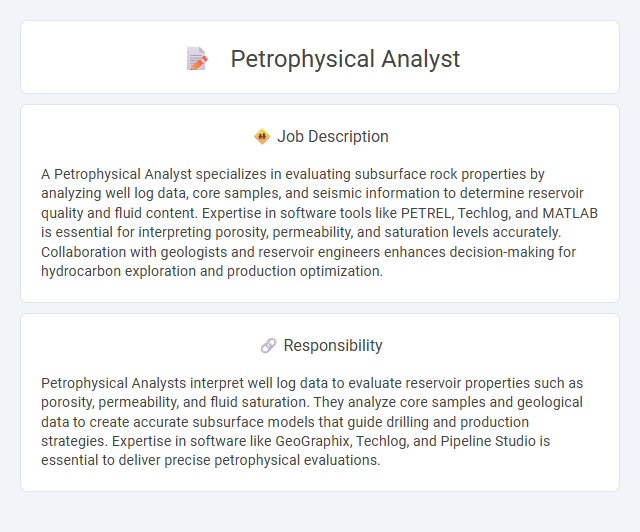
A Petrophysical Analyst specializes in evaluating subsurface rock properties by analyzing well log data, core samples, and seismic information to determine reservoir quality and fluid content. Expertise in software tools like PETREL, Techlog, and MATLAB is essential for interpreting porosity, permeability, and saturation levels accurately. Collaboration with geologists and reservoir engineers enhances decision-making for hydrocarbon exploration and production optimization.
Individuals with strong analytical skills and a keen interest in geology are likely to find a career as a Petrophysical Analyst suitable. Those comfortable working with data, interpreting subsurface formations, and focused on detail may have a higher probability of success in this role. Conversely, people who struggle with complex data analysis or lack patience for meticulous evaluation might find this job less fitting.
Qualification
A Petrophysical Analyst requires a strong foundation in geology, petroleum engineering, or geophysics, typically evidenced by a bachelor's degree in these fields. Proficiency in petrophysical software such as Techlog, Interactive Petrophysics (IP), or Petra is essential for accurate reservoir evaluation and interpretation. Advanced analytical skills, combined with expertise in data integration from well logs, core samples, and production data, enable precise reservoir characterization and optimization.
Responsibility
Petrophysical Analysts interpret well log data to evaluate reservoir properties such as porosity, permeability, and fluid saturation. They analyze core samples and geological data to create accurate subsurface models that guide drilling and production strategies. Expertise in software like GeoGraphix, Techlog, and Pipeline Studio is essential to deliver precise petrophysical evaluations.
Benefit
A Petrophysical Analyst likely enhances reservoir characterization, which can improve decision-making in drilling and production strategies. Their work probably contributes to more accurate estimations of hydrocarbon volumes, potentially increasing operational efficiency and reducing costs. Companies may benefit from their insights by optimizing resource extraction and mitigating risks associated with reservoir uncertainties.
Challenge
A Petrophysical Analyst role likely involves interpreting complex geological data to assess reservoir properties, which can present significant challenges due to the variability and uncertainty inherent in subsurface formations. Accurately integrating data from multiple sources such as well logs, core samples, and seismic surveys may require advanced analytical skills and attention to detail. The challenge often lies in producing reliable estimates that support optimal decision-making in hydrocarbon exploration and production.
Career Advancement
Petrophysical Analysts possess specialized skills in evaluating subsurface rock properties using well logs and core data, essential for optimizing hydrocarbon recovery. Career advancement typically involves progression from entry-level analysis roles to senior positions such as Senior Petrophysicist, Reservoir Engineer, or Geoscience Team Lead, where strategic decision-making and integrated reservoir modeling become key responsibilities. Pursuing certifications like the Society of Petrophysicists and Well Log Analysts (SPWLA) and gaining expertise in advanced software tools such as Petrel and Techlog significantly enhance promotion prospects and industry recognition.
 kuljobs.com
kuljobs.com